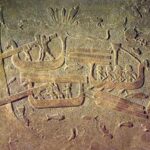
Bursting onto the scene in the 13th and 12th centuries BC, these shadowy coastal marauders left a devastating imprint on the eastern Mediterranean. Rising from the depths of obscurity, their sudden emergence coincided perfectly with the catastrophic downfall of regional powers, unleashing chaos across the land. These ravenous bands didn’t just make waves; they crashed into the Hittites, Mycenaeans, and Egyptians—causing mayhem wherever they went.
Enter Ramesses III of Egypt, a key player in this tumultuous saga, who took on the Sea Peoples in a series of brutal confrontations. His celebrated victories at Djahy, the Siege of Dor, and along the Nile Delta are etched in stone on the walls of his mortuary temple at Medinet Habu, a testament to his prowess. Yet, despite his triumphs, the Sea Peoples persisted as a formidable menace, wreaking havoc without remorse.
But it wasn’t just Egypt feeling the heat. The Sea Peoples clashed in the Battle of the Amuq Plain, where Ramesses III again triumphed over the Tjeker and Peleset. These violent engagements scream of the intense and often bloody warfare between these enigmatic seafaring groups and established empires.
However, the ultimate fate of the Sea Peoples is a tantalizing enigma that continues to perplex historians. Did they integrate into other cultures, simply fade away, or transform into new entities? The legacy of the Sea Peoples remains a tantalizing puzzle, captivating minds and sparking debates about their true impact on history.










Leave a Reply